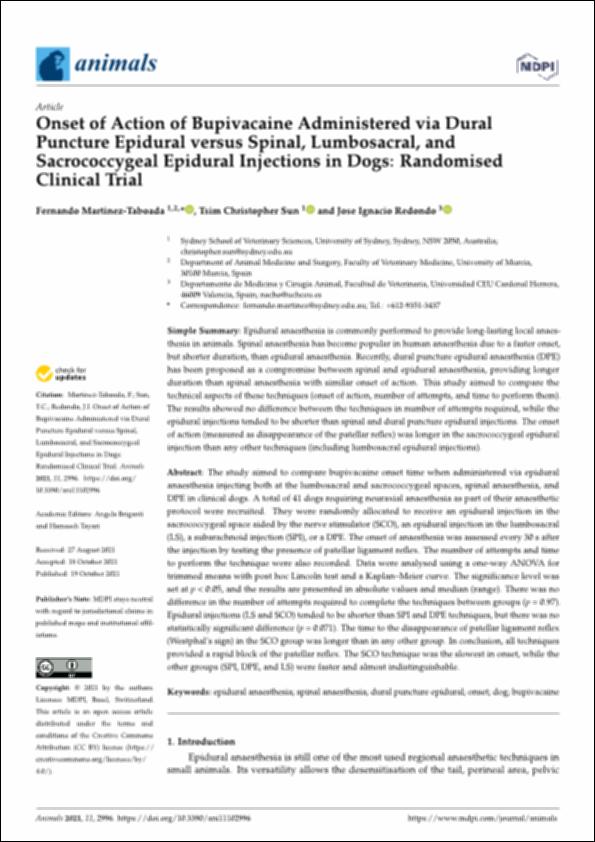Please use this identifier to cite or link to this item:
http://hdl.handle.net/10637/13453Onset of action of Bupivacaine administered via dural puncture epidural versus spinal, lumbosacral, and sacrococcygeal epidural injections in dogs : randomised clinical trial
| Title: | Onset of action of Bupivacaine administered via dural puncture epidural versus spinal, lumbosacral, and sacrococcygeal epidural injections in dogs : randomised clinical trial |
| Authors : | Martínez Taboada, Fernando Sun, Tsim Christopher Redondo García, José Ignacio |
| Keywords: | Bupivacaína.; Anestesia veterinaria.; Perros - Anestesia.; Bupivacaine.; Veterinary anesthesia.; Dogs - Anesthesia. |
| Publisher: | MDPI |
| Citation: | Martinez-Taboada, F., Sun, T. C. & Redondo, J.I. (2021). Onset of action of Bupivacaine administered via dural puncture epidural versus spinal, lumbosacral, and sacrococcygeal epidural injections in dogs: randomised clinical trial. Animals, vol. 11, i. 10 (19 oct.), art. 2996. DOI: https://doi.org/10.3390/ani11102996 |
| Abstract: | The study aimed to compare bupivacaine onset time when administered via epidural anaesthesia injecting both at the lumbosacral and sacrococcygeal spaces, spinal anaesthesia, and DPE in clinical dogs. A total of 41 dogs requiring neuraxial anaesthesia as part of their anaesthetic protocol were recruited. They were randomly allocated to receive an epidural injection in the sacrococcygeal space aided by the nerve stimulator (SCO), an epidural injection in the lumbosacral (LS), a subarachnoid injection (SPI), or a DPE. The onset of anaesthesia was assessed every 30 s after the injection by testing the presence of patellar ligament reflex. The number of attempts and time to perform the technique were also recorded. Data were analysed using a one-way ANOVA for trimmed means with post hoc Lincoln test and a Kaplan–Meier curve. The significance level was set at p < 0.05, and the results are presented in absolute values and median (range). There was no difference in the number of attempts required to complete the techniques between groups (p = 0.97). Epidural injections (LS and SCO) tended to be shorter than SPI and DPE techniques, but there was no statistically significant difference (p = 0.071). The time to the disappearance of patellar ligament reflex (Westphal’s sign) in the SCO group was longer than in any other group. In conclusion, all techniques provided a rapid block of the patellar reflex. The SCO technique was the slowest in onset, while the other groups (SPI, DPE, and LS) were faster and almost indistinguishable. |
| Description: | Este artículo se encuentra disponible en la siguiente URL: https://www.mdpi.com/2076-2615/11/10/2996 Este artículo pertenece al número especial "Loco-Regional Anaesthesia in Veterinary Medicine". |
| URI: | http://hdl.handle.net/10637/13453 |
| Rights : | http://creativecommons.org/licenses/by/4.0/deed.es |
| ISSN: | 2076-2615 (Electrónico) |
| Issue Date: | 19-Oct-2021 |
| Center : | Universidad Cardenal Herrera-CEU |
| Appears in Collections: | Dpto. Medicina y Cirugía Animal |
Items in DSpace are protected by copyright, with all rights reserved, unless otherwise indicated.


